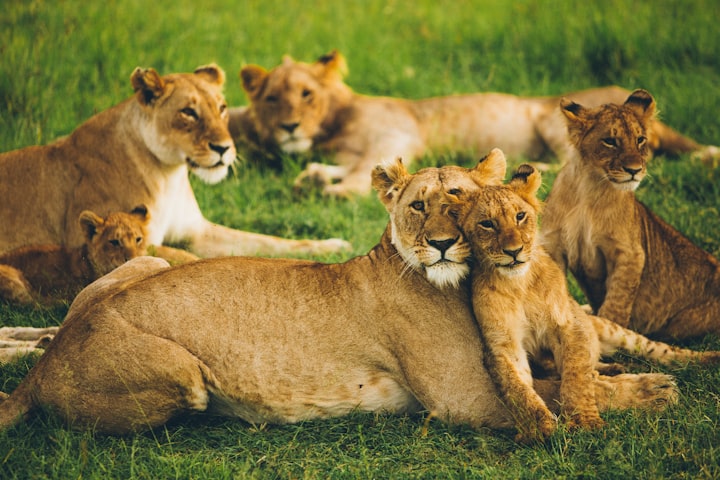
Lions
Lions are majestic creatures and are often referred to as the king of the jungle. With their golden mane, impressive roar, and powerful presence, lions are one of the most recognizable animals in the world. They are members of the cat family and are the only social cat species, meaning that they live in groups called prides.
Physical Characteristics
Lions are big cats and are the second-largest after tigers. Adult male lions can weigh between 330 to 550 pounds and can grow up to 10 feet long, including their tail. Female lions, on the other hand, are smaller and weigh around 265 to 395 pounds. Lions are known for their distinctive mane, which is a thick growth of hair that surrounds the male lion's head and neck. The color of a lion's fur ranges from light brown to dark brown, and the fur on the lion's belly is lighter in color.
Behavior
Lions are apex predators and are known for their hunting prowess. They are primarily active at night and rest during the day, which helps them conserve energy for hunting. Lions are social animals and live in prides that can consist of up to 30 individuals. A pride typically consists of one to three adult males, several females, and their cubs. Lions are territorial animals, and prides defend their territory against other lions.
Lions are known for their impressive roar, which can be heard up to five miles away. They use their roar to communicate with other lions in their pride and to warn off intruders. In addition to their roar, lions also communicate through body language, such as tail flicks and ear movements.
Diet
Lions are carnivores and primarily feed on large mammals, such as zebras, antelopes, and buffalos. They are opportunistic hunters and will also prey on smaller animals, such as hares and birds. Hunting is primarily done by the lionesses in the pride, who work together to take down prey. Male lions are generally not involved in hunting and will only join in if the prey is particularly large or dangerous.
Conservation Status
As mentioned earlier, the lion population is declining rapidly, and they are currently listed as a vulnerable species on the IUCN Red List of Threatened Species. The main threats to lions include habitat loss, poaching, and conflict with humans.
Habitat loss is a significant threat to lions, with their natural habitats being destroyed due to human activities such as deforestation, agriculture, and urbanization. As a result, lion populations are becoming increasingly fragmented, making it more difficult for them to find food and mates.
Poaching is another major threat to lions, with some parts of Africa still allowing hunting for sport, and their body parts and bones being used in traditional medicine. The illegal trade in lion bones is also increasing, with the demand coming primarily from Southeast Asia, where they are used in traditional medicine.
Conflict with humans is also a significant threat to lions, with human settlements expanding into lion territories. This results in increased human-lion interactions, leading to conflicts that often result in the killing of lions.
To address these threats, conservation efforts are underway to protect lion populations. The establishment of protected areas and anti-poaching initiatives are being implemented to reduce human-lion conflict and limit the impact of habitat loss.
Education and awareness-raising campaigns are also being conducted to help people understand the importance of lions and the need to protect them. By working together, we can ensure that lions continue to thrive in their natural habitats and that future generations can enjoy the beauty and majesty of these magnificent animals.
Conclusion
lions are fascinating animals that play a vital role in their ecosystem. They are apex predators and are known for their impressive hunting skills, social behavior, and iconic appearance. However, lions face numerous threats, including habitat loss, poaching, and conflict with humans. It is essential that we take steps to protect these magnificent animals, such as establishing protected areas and anti-poaching initiatives. By working together, we can ensure that future generations have the opportunity to appreciate the beauty and majesty of lions in the wild.






Comments
There are no comments for this story
Be the first to respond and start the conversation.